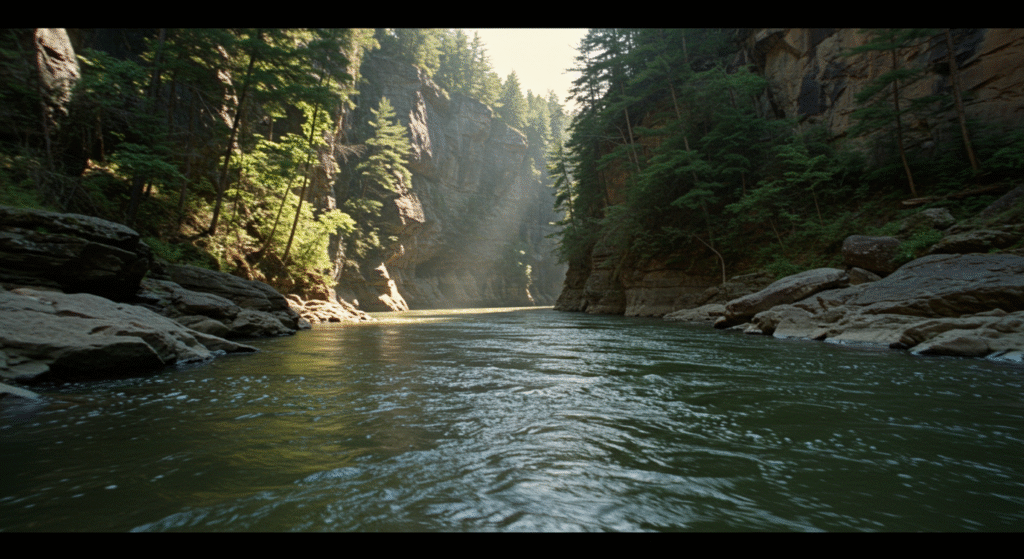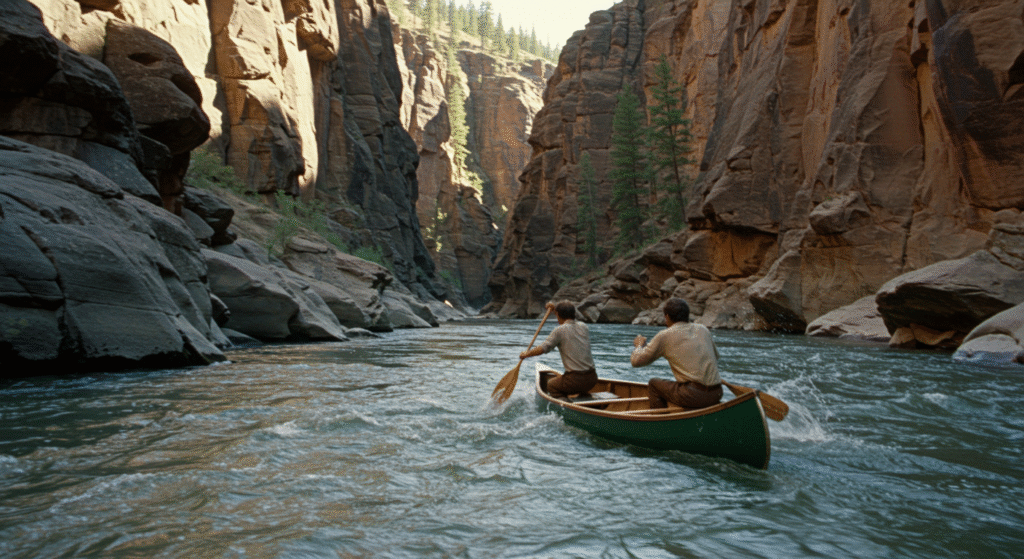Deliverance Will Break You Before It Sets You Free
Deliverance: A Genre-Bending Masterpiece
John Boorman’s 1972 film Deliverance isn’t just another movie about an outdoor adventure gone wrong. It shatters expectations and defies categorization. While it features the classic elements of an outdoor adventure film – breathtaking natural scenery, a group of friends embarking on a challenging journey – Deliverance takes a sharp turn into the dark and unsettling. The film quickly transforms into a harrowing tale of survival, but it also delves deeper, becoming a chilling exploration of human nature under extreme duress.

Adapted from James Dickey’s novel of the same name, Deliverance isn’t for the faint of heart. The film’s raw portrayal of violence and the brutality of the wilderness can be disturbing for some viewers. However, for those seeking a film that goes beyond typical genre tropes and offers a truly suspenseful and thought-provoking experience, Deliverance is a must-watch. It’s a masterpiece of suspenseful storytelling that will stay with you long after the credits roll.
The film’s brilliance lies in its ability to subvert expectations. We begin with a seemingly lighthearted adventure – a group of friends enjoying a canoe trip through a stunning landscape. But as the story progresses, the mood darkens considerably. The friends’ encounter with the mountain men becomes a turning point, shattering their sense of security and plunging them into a desperate struggle for survival. Deliverance isn’t afraid to explore the darker aspects of human nature, forcing the characters to confront their own fears and vulnerabilities in the face of unimaginable danger.
From City Slickers to Desperate Survivors
Deliverance takes us on a journey with four friends – Lewis (Burt Reynolds), Ed (Jon Voight), Bobby (Ned Beatty), and Drew (Ronny Cox) – as they trade the familiar routines of city life for a thrilling white-water canoe adventure down the fictional Cahulawassee River in Georgia. These men are accustomed to the comforts and conveniences of civilization – predictable schedules, readily available resources, and a sense of control over their environment. However, their decision to embark on this wilderness adventure throws them headfirst into a world that’s far removed from anything they’ve ever known.
The initial scenes paint a picture of camaraderie and lighthearted enjoyment. The friends relish the breathtaking scenery and the thrill of navigating the rapids. But this sense of carefree adventure is shattered when they encounter a pair of menacing mountain men. These men represent a way of life that’s vastly different from the friends’ urban existence. They embody a deep connection to the wilderness, a self-reliance honed by years of living off the land and facing the challenges of nature head-on. This chance encounter becomes a pivotal moment in the film, setting the stage for a series of events that will test the friends’ resolve in unimaginable ways. The encounter forces them to confront their own limitations and vulnerabilities, stripping away their sense of security and forcing them to adapt to survive in a world where the rules of civilization no longer apply.
A Grueling Ordeal that Pushes Limits
As the tension between the friends and the mountain men explodes, Deliverance takes a sharp turn into a desperate fight for survival. Gone are the days of carefree adventure. Now, the friends face not only the dangers of the unforgiving wilderness – raging rapids, treacherous terrain, and scarce resources – but also a terrifying confrontation with the dark side of human nature. What unfolds is a grueling ordeal that pushes them to their absolute physical and mental limits.
Burt Reynolds delivers a powerhouse performance as Lewis, the embodiment of macho bravado. Determined to protect his friends and prove his toughness, Lewis embodies the initial response to this crisis – a desperate attempt to maintain control and dominance in the face of overwhelming adversity. However, as the situation worsens, Lewis is forced to confront the limitations of his bravado.
Jon Voight shines as Ed, a character who undergoes a profound transformation throughout the film’s harrowing journey. Unlike Lewis, Ed is more introspective and contemplative. As the group’s ordeal progresses, Ed is forced to shed his preconceived notions and adapt to the harsh realities of their situation. This transformation goes beyond just physical survival; it’s a psychological and emotional journey that forces Ed to confront his own vulnerabilities and discover a strength he never knew he possessed.

The ordeal also puts a strain on the entire group’s bond. Their initial camaraderie is tested as they grapple with fear, exhaustion, and the constant threat of violence. The friends are forced to rely on each other in ways they never imagined, and their ability to adapt and overcome these challenges will ultimately determine their survival. Deliverance is a powerful exploration of human resilience in the face of unimaginable hardship, showcasing the strength that can emerge from desperation and the transformative power of facing our deepest fears.
A Scene Etched in Memory: Brutality and the Shattered Illusion
One scene in Deliverance has become a permanent fixture in cinematic memory, not for its entertainment value, but for its raw and unflinching portrayal of violence. Here, Ned Beatty’s character, Bobby, is subjected to a horrific assault, a scene that lingers long after the credits roll. The film doesn’t shy away from the brutality, but it doesn’t resort to unnecessary sensationalism either. This lack of Hollywood embellishment is precisely what makes the scene so disturbing and impactful.
The scene’s power lies in its ability to shatter the illusion of a peaceful wilderness adventure. Up to this point, the audience has been enjoying the scenery and the camaraderie between the friends. The sudden eruption of violence throws everything into stark contrast. It serves as a brutal reminder that the wilderness can be a dangerous place, devoid of the civility and safety nets of the modern world.
Beyond the immediate shock, the scene also forces us to confront the darkness that can lurk within humanity. The act of violence is not portrayed as a thrilling spectacle, but as a horrifying display of human cruelty. It raises uncomfortable questions about human nature and the potential for savagery under extreme circumstances.
In this way, the scene becomes more than just a display of violence; it becomes a turning point in the film’s narrative. It shatters the sense of security the friends previously held and plunges them into a desperate struggle for survival. The idyllic wilderness adventure they envisioned is now a fight for life, forever tainted by the trauma of this horrific encounter.
Nature as Threat and Ally
The cinematography in Deliverance is a masterclass in building suspense and mirroring the emotional journey of the characters. The lush landscapes of Georgia, initially presented as a scenic backdrop for the friends’ adventure, take on a haunting quality as the situation escalates. The beauty of the wilderness becomes a constant reminder of the danger that lurks beneath the surface.
The camerawork is deliberate, often using long, tracking shots that showcase the vastness and isolation of the environment. We feel trapped alongside the characters, dwarfed by the towering trees and the relentless flow of the river. The use of natural light and minimal special effects further enhances the film’s realism, immersing the audience in the harsh beauty and inherent dangers of the wilderness.
But nature isn’t just a passive observer in Deliverance. The Cahulawassee River itself transforms from a peaceful waterway into a treacherous obstacle course, mirroring the growing tension and desperation of the characters. The churning rapids and hidden rocks become menacing threats, constantly testing the friends’ skills and resolve. The once-inviting river has become a force to be reckoned with, a constant reminder of their vulnerability and the precariousness of their situation.
This masterful blend of breathtaking visuals and suspenseful camerawork elevates Deliverance beyond a simple adventure story. It creates a truly immersive experience, where the beauty and power of nature become both a source of wonder and a terrifying threat. The wilderness is no longer a playground, but a complex force that can be both ally and adversary, its beauty masking the potential for danger. This interplay between awe and terror is what makes Deliverance such a compelling and unforgettable film.
Deliverance: A Genre-Bending Masterpiece, Not for the Faint of Heart
Deliverance isn’t your typical feel-good adventure movie. It’s a dark, intense, and thought-provoking experience that burrows under your skin and stays with you long after the credits roll. This 1972 film by John Boorman isn’t for the faint of heart. It shuns the conventional happy ending often found in Hollywood, opting for a more realistic and unsettling portrayal of survival. However, for those who appreciate a film that challenges expectations and pushes boundaries, Deliverance is a masterpiece of suspenseful storytelling. It’s a film that will make you think twice about your next white-water adventure – and definitely pack a life jacket, just in case.
Be warned: Deliverance is not sunshine and rainbows. It delves into the darker side of human nature and the harsh realities of the wilderness. The film doesn’t shy away from violence, and it portrays it in a raw and unflinching manner, devoid of Hollywood sensationalism. This adds a layer of realism that can be disturbing for some viewers.
Yet, it’s precisely this unflinching portrayal that elevates Deliverance from a simple genre film to a thought-provoking exploration of human resilience. The characters are forced to confront their deepest fears and vulnerabilities as they fight for survival. We witness the breakdown of their initial camaraderie as they grapple with fear, exhaustion, and the constant threat of violence. But amidst the darkness, we also see moments of courage and selflessness that emerge from this desperate struggle.
Deliverance is more than just a suspenseful thriller; it’s a film that lingers in your mind long after the viewing. It raises questions about human nature, the power of the wilderness, and the will to survive. It’s a film that will stay with you, a testament to the power of masterful storytelling and its ability to challenge and provoke its audience. So, if you’re looking for a film that will keep you on the edge of your seat and make you think, Deliverance is a must-watch. Just make sure you have a strong stomach and a healthy respect for the power of nature.
